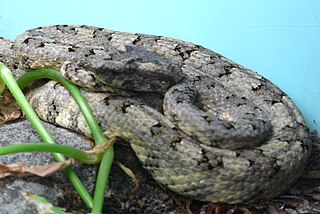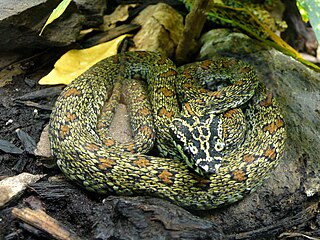
Trimeresurus is a genus of pit vipers found in Asia from the Indian Subcontinent throughout Southeast Asia, China, and the Pacific Islands. Currently 44 species are recognized. Common names include Asian palm pit vipers, Asian lanceheads, and green pit vipers.

Protobothrops jerdonii, also known commonly as Jerdon's pit viper, the yellow-speckled pit viper, and the oriental pit viper, is a species of venomous snake in the subfamily Crotalinae of the family Viperidae. The species is native to India, Nepal, Myanmar, China, and Vietnam. Three subspecies are recognized, including the nominate subspecies described here.

Protobothrops mucrosquamatus is a pit viper species endemic to Asia. Common names include: brown-spotted pit viper, Taiwanese habu and pointed-scaled pit viper. No subspecies are currently recognized. The species was first described by Theodore Cantor in 1839.

Protobothrops mangshanensis, commonly known as the Mangshan pit viper, Mangshan pit viper, Mt. Mang pit viper, or Mang Mountain pit viper, is a pit viper species endemic to Hunan and Guangdong provinces in China. No subspecies are currently recognized. This is a nocturnal pit viper that is also known as the ''Mangshan iron-head snake'', ''Chinese pit viper'', and the ''Ironhead viper''. They eat frogs, birds, insects, and small mammals. They have a white tail tip that they wiggle to mimic a grub so that prey comes into striking range—a behaviour known as caudal luring. The venom causes blood clotting and corrodes muscle tissue and can be fatal to humans if not treated. Unusually for vipers, P. mangshanensis is oviparous with the female laying clutches of 13–21 eggs which she will guard until they hatch.

Gloydius blomhoffii, commonly known as the mamushi, Japanese moccasin, Japanese pit viper, Qichun snake, Salmusa or Japanese mamushi, is a pit viper species found in Japan. It was once considered to have 4 subspecies, but it is now considered monotypic.

The Ryukyu Islands, also known as the Nansei Islands or the Ryukyu Arc, are a chain of Japanese islands that stretch southwest from Kyushu to Taiwan: the Ryukyu Islands are divided into the Satsunan Islands and Okinawa Prefecture. The larger ones are mostly volcanic islands and the smaller mostly coral. The largest is Okinawa Island.

Protobothrops cornutus, commonly known as the horned pit viper or Fan-Si-Pan horned pit viper, is a pit viper species found in northern and central Vietnam and in southern China (Guangdong). No subspecies are currently recognized.

Kikaijima is one of the Satsunan Islands, classed with the Amami archipelago between Kyūshū and Okinawa.
Protobothrops jerdonii bourreti, commonly known as Bourret's pitviper, is a subspecies of venomous pit viper in the family Viperidae. The subspecies is endemic to Vietnam.

Ovophis okinavensis, commonly known as the hime habu (ヒメハブ), Ryukyu Island pit viper, and the Okinawan pitviper, is a pit viper species found in the Ryukyu Islands of Japan. No subspecies are currently recognized.

Protobothrops elegans is a pit viper species endemic to Japan in the southern Ryukyu Islands. No subspecies are currently recognized. Common names include: elegant pit viper, Sakishima habu (サキシマハブ), and elegant tree viper.

Protobothrops flavoviridis is a species of pit viper endemic to the Ryukyu Islands of Japan. No subspecies are currently recognized. Local common names include habu, Okinawa habu, and Kume Shima habu.

Protobothrops xiangchengensis, commonly known as the Szechwan pit viper, Kham Plateau pit viper, or Sichuan lancehead, is a pit viper species endemic to the Hengduan Mountains in south-central China. No subspecies are currently recognized.
Trimeresurus fasciatus is a venomous pit viper species endemic to Djampea Island, Indonesia. No subspecies are currently recognized. Common names include: banded pitviper and banded tree viper.
Protobothrops kaulbacki, commonly known as Kaulback's lance-headed pit viper or Kaulback's lance-headed pit viper, is a pit viper species endemic to Asia. There are no subspecies that are recognized as being valid.

Trimeresurus gracilis, commonly known as the Taiwan pit viper or Taiwan mountain pitviper, is a venomous pit viper species endemic to Taiwan. No subspecies are currently recognized. The species is known as kikushi habu in Japanese.

Protobothrops jerdonii xanthomelas is a venomous pit viper subspecies endemic to China.

The Satsunan Islands is a geopolitical name for a group of islands that forms the northern part of the Ryukyu Islands. The whole island group belongs to Kagoshima Prefecture, Japan.
![Trimeresurus flavoviridis tokarensis (Protobothrops tokarensis)[Ri Ben She Lei Tu Pu ] Maki 1933 pl LXXXV (cropped).jpg](http://upload.wikimedia.org/wikipedia/commons/thumb/9/99/Trimeresurus_flavoviridis_tokarensis_%28Protobothrops_tokarensis%29%E3%80%8C%E6%97%A5%E6%9C%AC%E8%9B%87%E9%A1%9E%E5%9B%B3%E8%AD%9C%E3%80%8DMaki_1933_pl_LXXXV_%28cropped%29.jpg/220px-Trimeresurus_flavoviridis_tokarensis_%28Protobothrops_tokarensis%29%E3%80%8C%E6%97%A5%E6%9C%AC%E8%9B%87%E9%A1%9E%E5%9B%B3%E8%AD%9C%E3%80%8DMaki_1933_pl_LXXXV_%28cropped%29.jpg)














